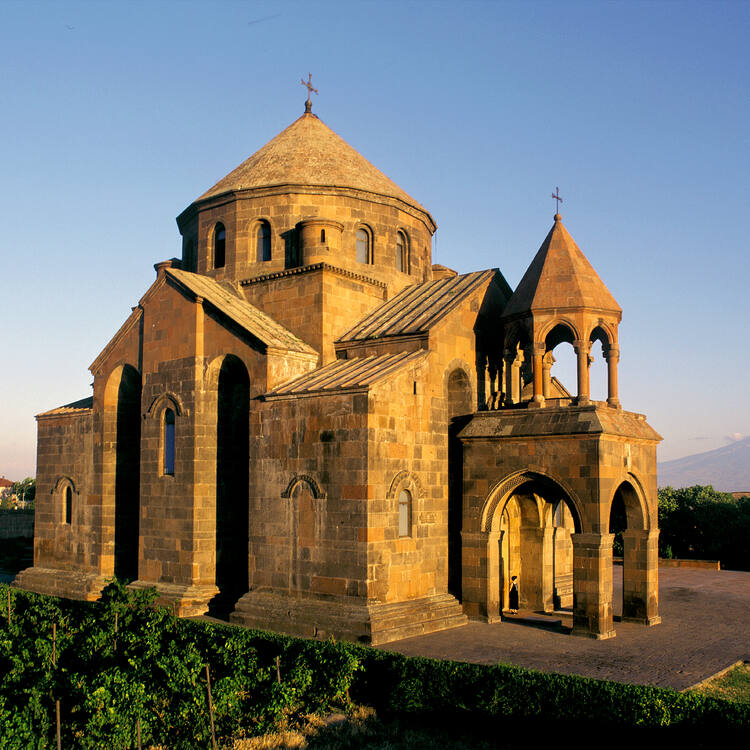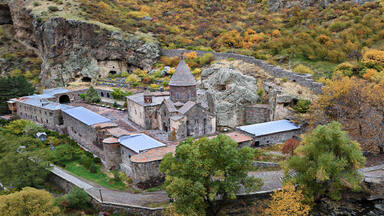Cathedral and Churches of Echmiatsin and the Archaeological Site of Zvartnots
Cathedral and Churches of Echmiatsin and the Archaeological Site of Zvartnots
The cathedral and churches of Echmiatsin and the archaeological remains at Zvartnots graphically illustrate the evolution and development of the Armenian central-domed cross-hall type of church, which exerted a profound influence on architectural and artistic development in the region.
Description is available under license CC-BY-SA IGO 3.0
Cathédrale et les églises d’Etchmiadzine et le site archéologique de Zvarnotz
La cathédrale et les églises d'Etchmiadzine, ainsi que les vestiges archéologiques de Zvarnotz illustrent de manière vivante l'évolution et l'épanouissement de l'église-halle arménienne à coupole centrale et plan cruciforme, qui ont profondément influencé le développement architectural et artistique de cette région.
Description is available under license CC-BY-SA IGO 3.0
كاتدرائية إتشميادزينه وكنائسها والموقع الأثري في زفارنوتز
تظهر كاتدرائية إتشميادزين وكنائسها بالإضافة إلى الآثار في زفانوتز تطوّر الكنيسة الكبيرة الأرمنية ذات القبة المركزية والتصميم على شكل صليب الذي كان له الأثر الكبير على التطوّر الهندسي المعماري والفني في المنطقة.
source: UNESCO/CPE
Description is available under license CC-BY-SA IGO 3.0
埃奇米河津教堂与兹瓦尔特诺茨考古遗址
埃奇米河津教堂与兹瓦尔特诺茨考古遗址形象地展示了亚美尼亚圆顶四瓣形教堂的发展演变过程,对该地区的建筑和艺术发展都产生了深远的影响。
source: UNESCO/CPE
Description is available under license CC-BY-SA IGO 3.0
Кафедральный собор и церкви Эчмиадзина и археологический памятник Звартноц
Кафедральный собор Эчмиадзина (основан 1700 лет назад) вместе с тремя древними церквями, также как и руины храма в Звартноце (середина VII в.), являются выдающимися памятниками армянской церковной архитектуры. Они наглядно иллюстрируют развитие и совершенствование армянских церквей крестово-купольного типа, оказавших основополагающее влияние на архитектуру и искусство этого региона.
source: UNESCO/CPE
Description is available under license CC-BY-SA IGO 3.0
Catedral e iglesias de Echmiatsin y sitio arqueológico de Zvarnotz
La catedral y las iglesias de Echmiadzin, así como los vestigios arqueológicos de Zvarnotz, ilustran de manera palpable la evolución y el florecimiento de las formas arquitectónicas de la característica iglesia-mercado armenia con cúpula central y planta cruciforme, elementos que ejercieron una profunda influencia en el desarrollo de la arquitectura y el arte de la región.
source: UNESCO/CPE
Description is available under license CC-BY-SA IGO 3.0
エチミアツィンの大聖堂と教会群及びズヴァルトノツの古代遺跡
source: NFUAJ
De kathedraal en kerken van Echmiatsin en archeologisch Zvartnots
Source: unesco.nl
Outstanding Universal Value
Brief synthesis
The city of Echmiatsin is located in the Armavir Marz region of Armenia. The settlement has existed since ancient times, as evidenced by Stone, Bronze, and Iron Age archaeological sites located in and near the city. The oldest written information about Echmiatsin refers to the period of the Urartian King Rusa II (685-645 BC). The settlement was mentioned in the Urartian cuneiform inscription by the name of Kuarlini. Life in this Armenian settlement has continued uninterrupted. The town has been called, successively, Artimed, during the rule of Yervandunis (as evidenced by Armenian historian Movses Khorenatsi (5th century AD)), Vardgesavan, and afterwards Vagharshapat, during the age of development under the rule of King Vagharsh I Arshakuni (AD 117-140). The name Echmiatsin was used along with that of Vagharshapat after the adoption of Christianity (AD 301).
The inscribed property is divided into three separate areas: the first area includes the Mother Cathedral of Echmiatsin and St Gayane Church. The area is about 30.2 ha. 18.8 ha belongs to the Mother See of Echmiatsin (the Mother Cathedral and surrounding constructions covering 16.4 ha, the St Gayane Church and surrounding buildings covering 2.0 ha, and the cemetery of the congregation covering 0.4 ha) and 11.4 ha belongs to the community of Echmiatsin City. The second area includes St Hripsime Church and St Shoghakat Church. This area is about 25.3 ha, with 6.2 ha being the territory of St Hripsimeh Church, belonging to the Mother See. The remaining 19.2 ha belongs to the community of Echmiatsin City.
The third area consists of the archaeological site of Zvartnots, with the ruins of the temple, Catholicos Palace and other constructions, and occupies about 18.8 ha.
The first and the second areas together are surrounded with one common buffer zone of approximately 93 ha. The buffer zone of the third area is 24 ha.
The religious buildings of Echmiatsin and the archaeological remains at Zvartnots bear witness to the implantation of Christianity in Armenia and to the evolution of a unique Armenian ecclesiastical architecture, which exerted a profound influence on architectural and artistic development in the region. They graphically illustrate the evolution and flowering of the Armenian central-domed cross-hall type of church.
The earliest domed church is the Cathedral of Echmiatsin, which was built in AD 301-303 by King Trdat III (Tiridates) and St Gregory the Illuminator. Its cruciform plan with four apses and a central dome carried on four pillars is the outstanding contribution of Armenian ecclesiastical architecture to Christian architecture as a whole. This inventive discovery of Armenian architects spread beyond the country to Byzantium, and then to Central and Western Europe. Apart from its architectural qualities, the cathedral is distinguished from other Armenian churches by its original paintings of interior frescoes. From 1712 to 1721 Naghash Hovnatan worked there (the paintings on the upper part of the dome and the Holy Mother of God painted on the internal marble of the main apse are preserved). Hakob and Harutyun Hovnatanyans (first half of the 18th century) and Hovnatan Hovnatanyan (second half of the 18th century) have periodically created paintings for the Echmiatsin Cathedral. Mkrtum and Hakob Hovnatanyans also made paintings for the cathedral in the 19th century.
St Gayane Church (AD 630) is the earliest example in Early Christian and Armenian architecture to combine a three-aisle basilica with a central dome, a form which became widespread in both Armenia and Western Asia. It is a four-column domed basilica with harmonious proportions, a central nave and two sacristies built of well-processed tuff (a stone of volcanic origin). It is considered to be the best example of this type of church. The vaulted sepulcher of St Gayane the Virgin is located under the main apse, which is entered from the southeastern sacristy. The roof and walls of the church were renovated in 1652. A narthex-hall with three bays was built along the western façade of the church in 1683 with chapels at its north and south ends, dedicated to the Apostles Peter and Paul. The narthex-hall also served as a burial place for the Catholicoses.
The rampart of the monastery was added later. From 1866 to 1882, Abbot Vahan Bastamyan renovated the monastery, its arched gate, residential buildings for abbot and congregants, and school, and established a printing house.
Different types of central-domed churches developed in the Early Middle Ages and became widespread in Armenia during the 7th century. Among these, St Hripsime Church is the perfect example of the four-apse church with intermediate niches and corner rooms (AD 618). In the 1970s, archaeological excavations were conducted in the adjacent areas of the church, discovering pre-Christian and early-Christian burials and a one-nave church. Due to the brilliant combination of its construction system to maintain seismic stability, its decoration and its architectural style, St Hripsime Church has crystal lucidity. The structural system is the main expression of its artistic appearance.
St Shoghakat Church was built in 1694 on the place of the 4th-century chapel where the “ray of light was dropped” upon Christian Hripsime’s martyrs. The present-day church was built of brown well-processed tuff and is distinguished by its unique architecture.
St. Mariam Astvatsatsin Church was built in 1767 during the rule of Simeon Yerevantsi Catholicos. It is a three-aisled and span-roof basilica with three pairs of pilasters.
The initiative to develop new central domed and cross-shaped plans for churches resulted in Zvartnots Church which was built in the middle of the 7th century. It is considered to be a masterpiece, where the four-apse interior is contained within a three-storey circular structure with a polyhedral exterior. It was ruined in the 10th century, probably by an earthquake.
According to the proposed reconstruction (based on an 11th-century stone model of Gagkashen Church found during the excavations in Ani), the height of the church was about 45 m, which is unusually high for 7th-century construction techniques. Zvartnots has rich bas-reliefs. The bas-reliefs and high-reliefs that illustrate fragments from ecclesiastical and secular life are implemented very skillfully. These decorative elements were widespread in Armenian architecture from the second half of the 7th century. Zvartnots church is truly the apogee of all the achievements of Armenian architecture’s Golden Age (Early Middle Ages) in the spheres of construction, sculptural and decorative arts.
Criterion (ii): The developments in ecclesiastical architecture represented in an outstanding manner by the churches at Echmiatsin and the archaeological site of Zvartnots had a profound influence on church design over a wide region.
Criterion (iii): The churches at Echmiatsin and the archaeological site of Zvartnots vividly depict both the spirituality and the innovatory artistic achievement of the Armenian Church from its foundation.
Integrity
The churches within the property clearly bear witness to the implantation of Christianity in Armenia and to the evolution of a unique Armenian ecclesiastical architecture. The property contains sufficient structures to demonstrate the developments of ecclesiastical architecture. All these buildings, as well as the landscape, are sufficiently intact and have not been changed since the time of their inscription on the World Heritage List.
The main threats to the integrity of the site are its location in an active seismic zone, pollution of the surrounding environment, and the pressures of being on an active tourism route.
Authenticity
The authenticity of the ecclesiastical monuments is reasonable, given that they have been in religious use for many centuries, have been subject to changes in liturgy and fashion over that period, and have undergone periodic restoration. The archaeological site is fully authentic, since it consists solely of excavated remains of 31 vanished structures. However, some of the past restoration work is not fully in conformity with the principles of the Venice Charter.
Protection and management requirements
Only the Archaeological Site of Zvartnots is under State ownership and is situated on the territory of the Zvartnots historical and cultural museum-reservation, while the rest of the monuments are the property of the Armenian Apostolic Holy Church as well as being protected by the Law “On protection and usage of the historical and cultural immovable monuments and historical environment” of the Republic of Armenia, and by the regulation “On State registration, study, protection, fortification, restoration, reconstruction and usage of the historical and cultural immovable monuments”. Additional articles exist in the Civil, Administrative, Land, and Criminal Codes of the Republic of Armenia for the protection of the monuments.
The Ministry of Culture of Armenia with its specialized unit as the authorized state body and the Armenian Apostolic Holy Church with its specialized units and dioceses as owner, as well as non-governmental, nature protection units and people interested in Armenian heritage conservation, are engaged in the protection of the monastery complex. A consistent policy is carried out in order to present comprehensively the monuments included in the nomination. The permanent exhibitions of the museums at the Mother See and Zvartnots are updated over the course of time.
Issues concerning conservation, rehabilitation and use of the sites inscribed on the World Heritage List are discussed at the specialized councils formed by the Ministry of Culture of Armenia (methodological, architectural councils) and the Mother See of Holy Echmiatsin, where the representatives and professionals of both sides are equally represented. To meet the challenges facing the property over time within the boundaries of the site and in its main buildings, scientific research, renovation, reinforcement, design and preventive measures have been undertaken in order to ensure its authenticity. The lead was removed from the dome of the cathedral in 2000 and replaced by stone slabs.
The budget of the property is formed of the allocations from the State budget, entrepreneur activity, and private donations.

 View photos from OUR PLACE the World Heritage collection
View photos from OUR PLACE the World Heritage collection
